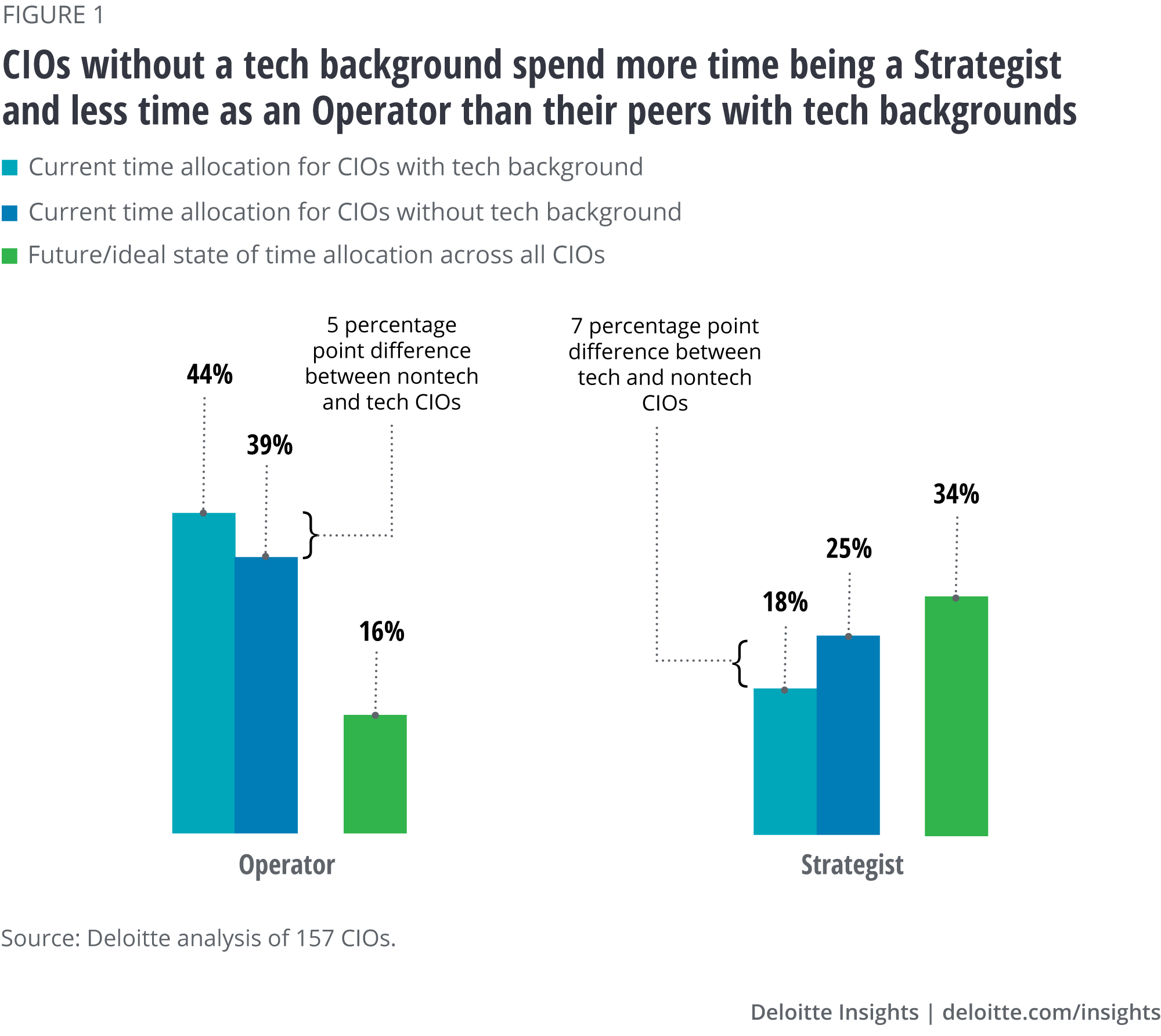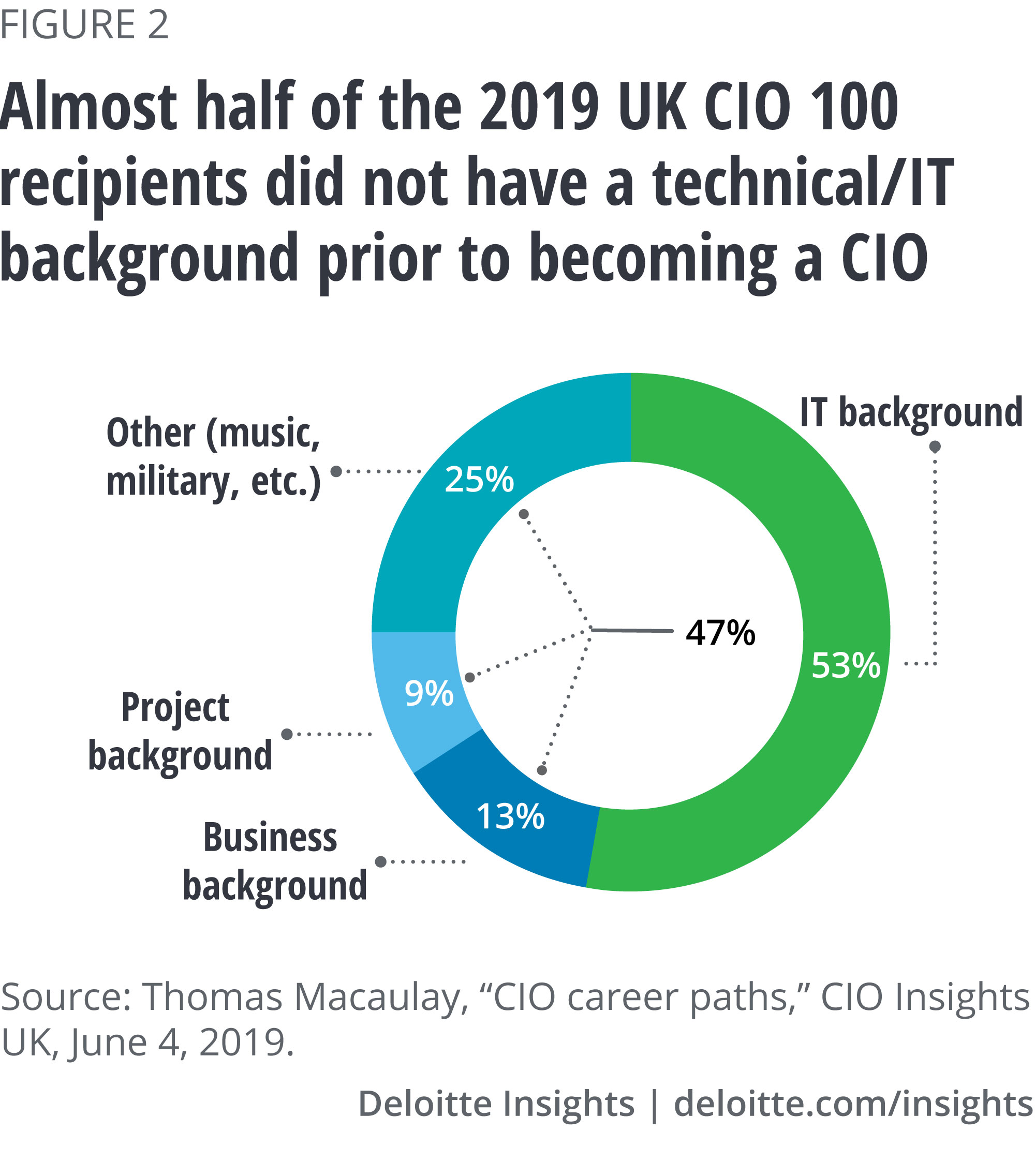
Paving diverse paths to technology leadership Diversity and Inclusion in Tech
13 minute read
06 March 2020
Do IT organizations only want to hire technologists? Think again. Research shows that IT organizations are becoming more diverse in their hiring—in fact, they seem to proactively look for and recruit those who, through their strategic thinking and intellectual curiosity, are able to bring a fresh perspective to the
table.
Share your perspective on Diversity, Equity, & Inclusion in Tech
Take the survey
It’s no secret that new and emerging technologies are upending business as usual. We’re seeing more and more companies with high-maintenance legacy systems moving to flexible cloud-based platforms. Meanwhile, business and functional leaders are becoming more tech savvy, and technology leaders are expanding their understanding of the business and customer.
Learn more
Explore the Diversity and Inclusion in Tech collection
This article is featured in Deloitte Review, issue 27
Download the issue
Learn about Deloitte’s services
Go straight to smart. Get the Deloitte Insights app
As on-site technology capabilities steadily shift to the cloud and outside the four walls of an organization, IT organizations’ talent needs are also changing. Increasingly, organizations need an expanded set of softer skills to translate business needs into technology solutions, in addition to the deep technology expertise required to execute those solutions. CIOs and IT leaders consistently have difficulty finding enough individuals who possess the full range of high-tech and soft skills required to keep pace in today’s complex, rapidly changing market.
But that may be a good thing.
Over the past decade, herculean efforts have been invested in attracting more diverse types of people into technology fields; however, the percentage of women graduating with computer science degrees has dropped—from 40 percent in the 1980s to less than 20 percent today.1
Here’s the irony: As technology organizations’ talent needs change, we find that the tech workforce is gradually becoming more diverse, even though computer science graduates remain predominately male. Perhaps that’s because advances in technology are driving more IT organizations to complement highly skilled technologists with colleagues who speak and understand the language of business to cover the gamut of new roles and responsibilities that technology teams are expected to deliver. Yes, IT still needs deep technologists, but it also should have people at all levels who think differently and bring a broader skillset and variety of experiences.
As IT organizations increasingly embrace diverse mindsets, new paths to tech leadership are also opening up. Of course, many next-generation tech leaders continue to follow the traditional path that begins with a tech-focused education and continues as they rise through the technology ranks. But there’s a new breed of tech leaders who come from diverse, nontechnical backgrounds where they developed critical thinking, problem-solving, communication, and other soft skills. Of course, technical skills are still fundamental, but this new breed of technologist is likely to have acquired their technology chops through work experiences, rather than a formal education in computer science or engineering.
As technology changes, so do tech leaders
Many enterprises today are harnessing disruptive technologies—especially cloud and digital—to drive business transformation and growth. Ninety percent of organizations use cloud-based services and they aren’t putting on the brakes.2 In fact, cloud investments are expected to double as a percentage of IT budget over the next three years.3 The use of cloud has given rise to everything-as-a-service, enabling any IT function to become a cloud-based service provider for enterprise.
With this transition, enterprise technology is now, more than ever, an assembly of “not-invented-here” technologies, which can be rapidly applied to address business challenges and opportunities. Rather than building new technology solutions from scratch, more IT organizations are identifying and implementing cloud-based applications and products—leveraging “off-the-shelf” services to enable elastic compute, modern data structures, machine learning, IoT, facial recognition, and more—and combining them like building blocks to address business issues. Ranjit Bawa, Deloitte’s US Cloud leader, says, “Tech leaders need to increasingly focus on ‘applied innovation’ or their ability to leverage ready-to-consume technology services, and apply them to their business use cases. This requires technology leaders to have a deep understanding of their business, an ability to apply technology solutions rapidly, and the financial acumen to drive strong ROI, as well as a societally responsible perspective. A deep background in technology is not critical, but intellectual curiosity, pragmatism, and bias for action are key.”4
This shift is helping enable IT departments to diversify skill sets to adjust to the mix of necessary technology competencies. Data suggests that IT organizations will continue to reduce the percentage of full-time employees from 82 percent to 75 percent of staff.5 While fewer full-time coders are needed, new roles—such as strategists and financial planners—are being created, which need soft skills for working with the business.
As they make hiring decisions, CIOs surveyed in Deloitte’s 2018 global CIO survey expect three soft skills to be significantly more important than others:
- Creativity. IT talent will be needed to design products, services, and solutions that address business issues, develop engaging user experiences, think creatively to solve thorny business problems, and brainstorm innovative business ideas.
- Cognitive flexibility. Learning agility—including the ability to see different perspectives, learn new skills, and adapt to change—will be increasingly critical.
- Emotional intelligence. To effectively collaborate and influence people across multiple business functions, IT staff will need to manage interpersonal communication and relationships.6
In response to this shift, many tech leaders’ primary role has been evolving from being a steward of technology to a partner in shaping the future of the business (see sidebar, “The changing faces of the tech executive”). Looking to the future, Lindsey Parker, chief technology officer (CTO) at DC government, predicts, “We’re not going to have a tech team anymore; we’re going to have a business team and there’s going to be a technology element.”7
The changing faces of the tech executive
Deloitte has identified four primary roles for tech executives, which we call the “four faces”:
- Operator: Delivers efficient IT services and solutions to support the business
- Technologist: Assesses technologies and designs technical architectures to support the business
- Strategist: Partners with the business to align business and IT strategies and maximize value of tech investments
- Catalyst: Instigates innovation through transformational change to business architecture, strategy, operations, and technology
When new CIOs transition into the role, we ask them how they’re currently spending their time across these four faces and how they aspire to spend their time. A trend we’ve seen across all newly transitioning CIOs is a desire to spend more time as a Strategist, and less as an Operator. CIOs from nontechnical backgrounds are closer in their desired time allocation to the Strategist and Operator than CIOs with technical backgrounds (figure 1). That may indicate that nontechnical CIOs come into the role with an advantage over their technical peers: They spend more of their day focused on the big picture, and less on the operational side.

Wanted: Technologists with diverse experiences
We’re seeing increasing demand for technology leaders’ soft skills—their ability to be business strategists, navigate C-suite and vendor relationships, and communicate effectively with their stakeholders—come up to par with the demand for their technical dexterity. According to a 2020 study conducted by Deloitte and WSJ Intelligence, 87 percent of CEOs agree that it is “more important now for technology leaders to understand business operations, strategy, and innovation than to have deep expertise in technology systems.”
As a result, more companies are placing less emphasis on a degree and career in tech, and more on an individual’s ability to understand and communicate how technology can help solve business problems and create value. Almost half of the recipients of the 2019 UK CIO100 award—which recognizes the most transformational and disruptive CIOs in and from the United Kingdom—did not have a technical/IT background prior to becoming CIO, while 53 percent reported treading a more traditional career path (figure 2). Those whose paths to the position were not rooted in tech were split among business (13 percent), project (9 percent), and a wide range of other (25 percent) backgrounds, from music to the military.8

One nontraditional tech leader is Rachel (Rae) Parent,9 who is now head of enterprise change at T. Rowe Price. After graduating with a liberal arts degree, she was hired by a company that was looking for entry-level people with broad backgrounds to bring into their technology organization. Its hiring model was to look for people with strong communications and problem-solving skills and develop them for careers in software design and installation. Step one was learning how to program. Parent admits she was “probably the worst COBOL programmer ever,” but she developed the essential technical skills that allowed her to work with the business to understand their needs and translate them into software requirements.
Today, Melissa Bell,10 CIO at Danaher, leads its global IT organization, enabling the enterprise’s digital transformation. She credits her effectiveness to her liberal arts education, which taught her “how to learn,” that is, how to prioritize massive amounts of information, figure out what’s most important, and express those ideas clearly, along with her own thoughts. Her learning agility led to a consulting job where she worked in advisory, business transformation, and systems implementation—giving her a “mini-MBA” and exposure to technology.
And there are others. Mark Roellig11 moved into the role of MassMutual’s chief technology and administrative officer from his position as the company’s general legal counsel. And Sally Gilligan12 leveraged her economics education and supply chain leadership role to become the CIO at Gap Inc.
But this is a relatively recent trend. According to Parent, tech recruiters, particularly those looking to fill more senior-level roles, “can be very focused on computer science or engineering degrees earned early on, and as a result, can miss out on candidates with the different types of perspectives provided by a nontraditional degree and on-the-job technology learning.” The idea that a nontechnical candidate can bring a broader perspective is still relatively new.
Still, 23 percent of the respondents to Deloitte 2020 global CIO survey have nontechnical educational backgrounds, as do an average 25 percent of their technology staff members (figure 3). As these leaders look to fill gaps in creativity and cognitive flexibility, they are bringing in people from nontraditional IT career paths, increasing the diversity of perspectives.

The softer side of tech leadership
While tech leaders should still ensure IT’s operational reliability, their strategic role as an enabler for cloud and digital transformation often requires a broader skill set. Melissa Bell says, “You need good, deep technical skills, and you need soft skills, which I prefer to call ‘consulting skills.’ You need to really understand the business—its strategy, customers, challenges—and build relationships to effectively influence transformation. Technology is moving so fast that learning agility is required to survive in this environment.”
Many of this new breed of tech leaders came to the role with a deep understanding of the business and its customers. Gilligan brought the ability to lead large organizations through transformational change. She brought her economics background and deep understanding of the customer and the business that she gained as a leader in Gap Inc.’s supply chain. She said, “For that reason, I was asked to lead our tech transformation, which requires bringing an organization through large-scale change.”
In Parker’s case, the mayor of the District of Columbia was looking for someone to lead the city’s IT organization who understood how to execute a campaign and get all stakeholders involved. Parker’s policy background and work as a strategic communicator enabled her to apply her knowledge of governance to help IT become better organized. Parker said, “If you think about any technology project, that’s what it needs. You need to contemplate all of the users, their journeys, and how you’re going to bring them along as you change the tools that they use to drive their operations.”
Parent’s soft skills, learned through studying the liberal arts, help her to drive meaningful and actionable discussions with teams of technologists. She says, “Solid technical perspective is a critical part of problem-solving, but leaders also need to understand how to foster collaboration across diverse teams and make space for ideas that are not rooted first in technology.”
Of course, many technologists have developed these leadership skills, but people sometimes naturally tend to revert to their comfort zones. Parent says, “Sometimes the deeper technologists will resort to technology-first problem-solving, whereas those who have had a variety of academic and professional experiences tend to ask questions of more stakeholders, collect multiple points of view, and make connections across technology and business teams.”
Roellig entered his tech leadership role at MassMutual without hands-on tech experience, but with lots of curiosity and willingness to learn. “At this point in my career, I’m probably not a very good lawyer or technologist, but I know how to lead large teams, particularly support teams that enable the overall organization.” He gained the essential technical knowledge he needed in his new role both internally, by spending time with and learning from his people, and externally, by reading and attending conferences with other technology leaders.
Our take: Filling the tech gap by creating diverse roles
Ranjit Bawa, US Cloud leader, and Kate Kustermann Rivera, Cloud Capability Development leader
Deloitte Consulting
Like many of our clients, Deloitte needs people with diverse mindsets and backgrounds to lead in today’s cloud-based tech environment. In addition to deep cloud tech skills, we also need people with communication and problem-solving skills and business acumen, who can develop effective strategies to apply cloud-based solutions to address our client’s business challenges and opportunities.
We know we cannot hire our way out of this problem; there simply are not enough cloud-skilled people in the market, period. That’s why we launched Deloitte’s Cloud Institute. By reskilling and upskilling some of our most promising professionals, we are building the industry’s most skilled cloud technology workforce to help lead the massive transformations our clients need to continue to grow and compete.
We created five role-based pathways—developer, engineer, architect, AI/analytics, and strategist. The first four require a strong tech background. But for the fifth—strategist—we look for professionals with a broader business background, often from our Human Capital and Strategy and Operations practice areas. They learn tech fundamentals and how to apply cloud-based technologies to deliver more value to our clients. Many of our modern delivery teams are cross functional in nature, with technology and functional experts, that complement each other and together delivery a superior outcome.
The Cloud Institute launched about a year ago, with its first cohort completing the foundational curriculum. Advanced and master curriculums for each pathway will support and encourage the continuous learning that’s required in this rapidly changing tech space. The Cloud Institute is just one of the many tactics Deloitte is using to attract, motivate, and retain the top-tier talent we need to serve our clients.
Advice for building the next generation of diverse tech leaders
Our conversations with the featured technology leaders who come from nontraditional backgrounds generated the following practical suggestions for CIOs and other leaders who are looking to fill IT talent gaps and build a more diverse and inclusive culture:
Cast a wider net. Bell finds diverse ideas and talent by building relationships outside her company and industry. She said, “I have a broad network working for me. I have relationships with multiple consultancies, local and national conference boards, and learning and development programs like Deloitte’s NextGen CIO Academy. So, I’m already meeting a wide range of folks before I even have a position to fill.”
Look beyond the degree. When developing, hiring, and retraining IT talent, consider the individual’s learning agility and other soft skills, which may matter more than educational background or formal work experience. Gilligan looks for “learning agility and a growth mindset. How do they approach a problem, and what are their critical thinking skills? Do they have the skills necessary and the learning agility to do a breadth of jobs? We look across a diversity of backgrounds and talents in order to find the best talent.”
Seek diverse perspectives. Gilligan invites new ideas from across her organization to understand how different people view the problem and how they might solve it. She says, “The solution you may have thought of may not be the optimum or best one. So, the more diversity of thought, the more likely you are to actually find the ideal solution.” Consider going even further by forcing yourself and your teams to take this to heart. Don't just encourage diverse viewpoints but keep each other honest and track them.
Create diverse roles. It takes a broad breadth of roles to run an effective IT organization, from deeply technical roles, which require highly specialized skills, to strategic and operational roles, which are less technical but require more interpersonal skills. Some companies, including Deloitte, are creating diverse roles—and customized learning curriculums—based on the technical and interpersonal/business skills required to be effective (see sidebar, “Our take: Filling the tech gap by creating diverse roles”).
Upskill and reskill. Organizations are finding that they cannot hire enough qualified people to fill the demand for certain specialized tech roles, such as in cybersecurity and cloud. Some are launching initiatives to upskill and reskill business and technology employees to fill critical high-demand roles.
Learn a common language. Some companies, including Danaher and Deloitte, are developing fluency programs. According to Bell, “It’s about tech fluency for business leaders, but also business fluency for tech leaders. The goal is to bridge the gap between the two so they can talk the same language.” Tech fluency programs for business professionals may also help tech leaders identify new talent that can fill strategic roles that align business issues with tech solutions.
Don’t skip the basics. Roellig encourages tech leaders with nontraditional backgrounds to “explore the core elements of technology. You probably want to know a little bit about coding, data analytics, algorithms, and how they are used. You don’t have to become an expert, but there is value in banging around on some of those analytical-type areas so at least you have some knowledge of what they are.”
Broaden young minds. Parker looks for opportunities to speak to young people—not just high school, but also elementary and middle school students. She shares her nontech background and lets them know that “you don’t have to be an engineer or have fifty advanced degrees to be successful in tech. But you do need to work really hard at it and think about how to deliver what people want.”
The time is now
It’s as if the stars have aligned to nudge technology organizations toward the broad-ranging benefits of diversity. As more technology capabilities move off-premise and into the cloud, IT organizations find that they need fewer full-time deep technologists. Simultaneously, they are creating new strategy-focused roles to align business goals with cloud-based technology solutions. These roles require business acumen and soft skills—creativity, cognitive flexibility, and emotional intelligence—that are more likely to be developed outside the traditional STEM education path and career.
As professionals with diverse experiences, education, and mindsets enter technology organizations, a new path to tech leadership is emerging. It’s not a coincidence that the diversity and inclusion initiatives that organizations have cultivated in recent years are beginning to pay off.
Diverse thinking is organically evolving from a “nice to have” to a “must have.” That doesn’t mean that technology leaders can back off. Our commitment to diversity and inclusion should remain top of mind to enable this new breed of tech leader to be effective in building bridges between the business and technology. Over time, we expect that there will be no distinction: All businesses will be technology minded, and all technology organizations will be business minded.
This article is part of an ongoing series of interviews with technology executives. The executives’ participation in this article are solely for educational purposes based on their knowledge of the subject, and the views expressed by them are solely their own. This article should not be deemed or construed to be for the purpose of soliciting business for any of the companies mentioned, nor does Deloitte advocate or endorse the services or products provided by these companies.
The Wall Street Journal news organization was not involved in the creation of this content.
Browse the CIO Insider collection
-
The future of work in technology Article5 years ago
-
Reimagining the role of technology Article5 years ago
-
Beyond innovation by shotgun Article5 years ago
-
Technology and the boardroom: A CIO’s guide to engaging the board Article5 years ago
-
The CIO's innovation agenda Summary

















